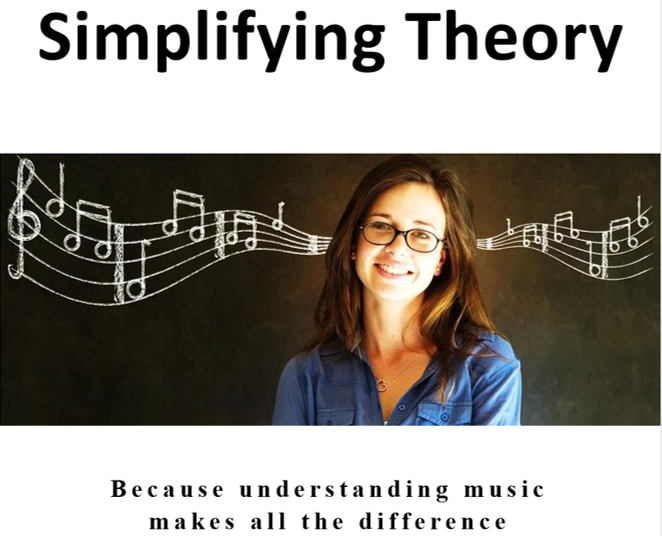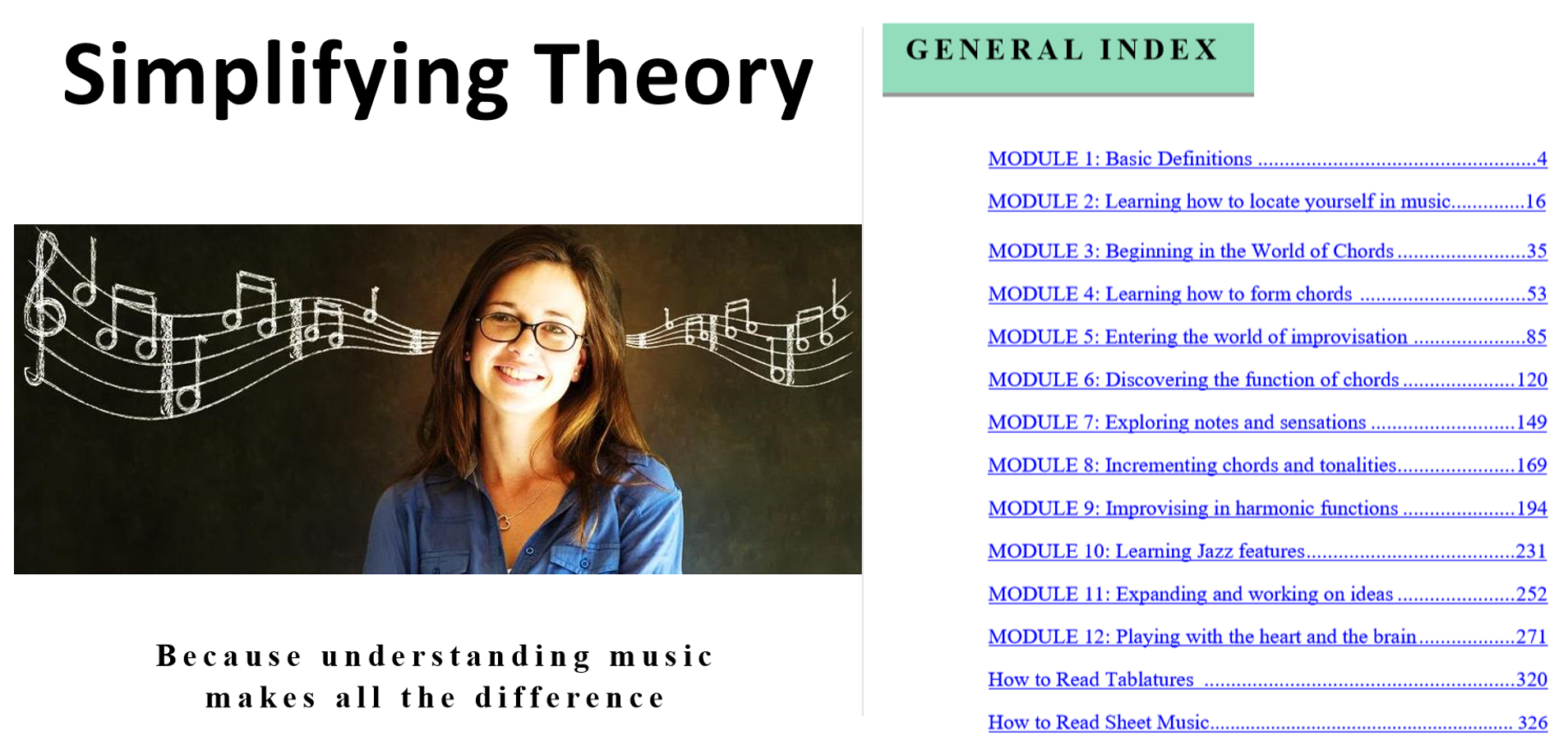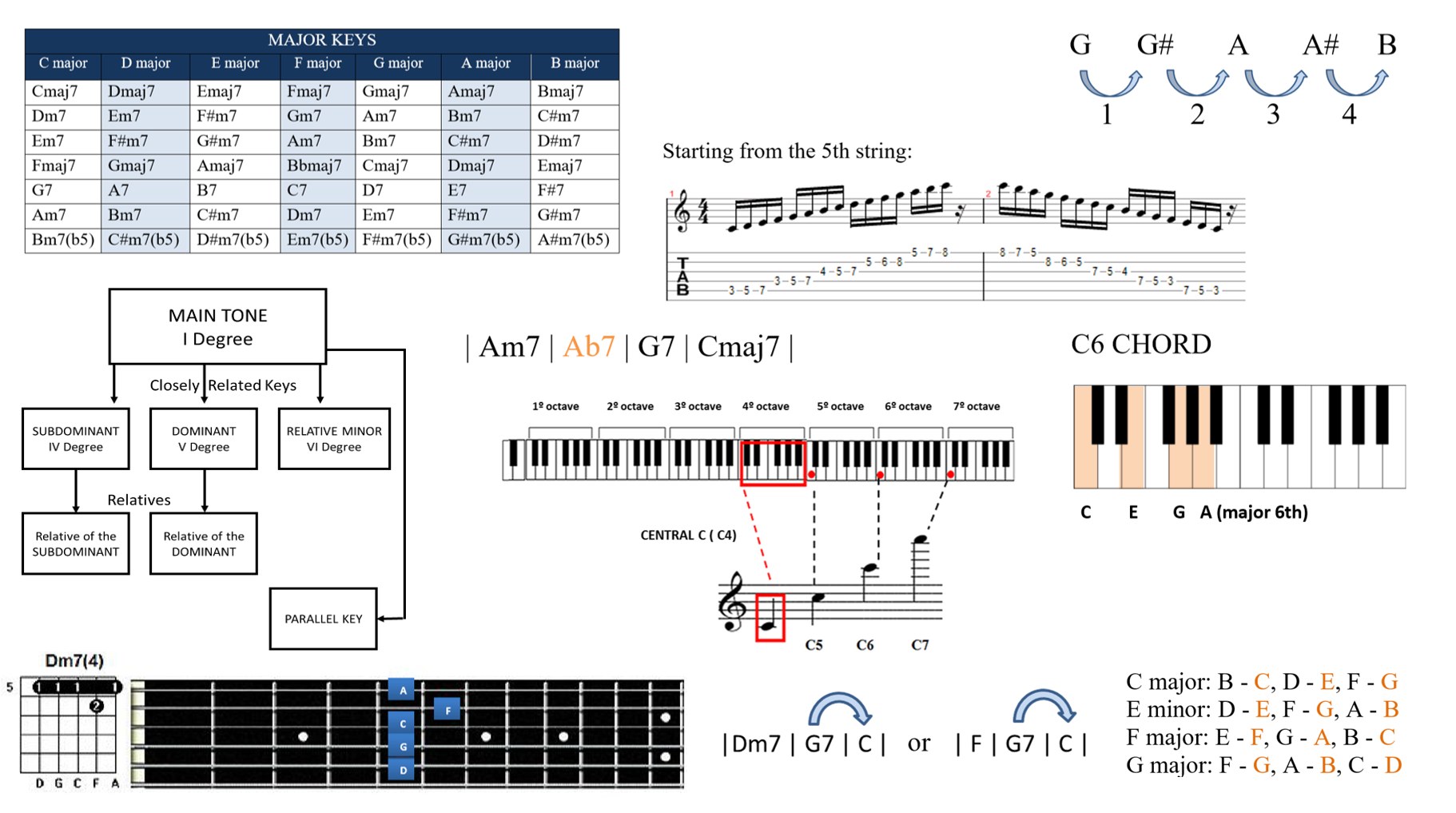 This booklet on music theory was specially prepared by the Simplifying Theory team, with over 350 pages of exclusive content.
This booklet on music theory was specially prepared by the Simplifying Theory team, with over 350 pages of exclusive content.
Many people have suffered when trying to learn music theory. If this is your case, there is no need to worry: music theory books and materials are usually very boring and difficult to understand, and this is not your fault. That feeling that it is only possible to learn music theory if you have a lot of prior knowledge is a lie.
Have you ever found material that explains everything right from the start, without any need to seek explanations elsewhere? Have you ever seen any carefully organised materials, set out module by module, with the student’s learning being the main concern?
The good news is that nowadays this material exists. Apart from having everything duly organised and very well explained, this is also the most complete and the most inclusive material on music theory that you could find.
Over 50,000 students have studied using our materials since 2014, and that number continues to grow each month. Students from all levels, from those who know nothing at all about music theory to those who have already worked as professional musicians: everyone has benefited from the Simplifying Theory course booklet.
What will you find in this booklet?
This booklet, presented in PDF format, has links in the menus, so you can browse through the document with much greater ease (on clicking the link in a menu, you shall be automatically directed to the page which contains that issue). Look at an example:

The quality of the material is the same as in the articles presented here on this site, carefully organised and containing exclusive content not available on the site. Didactic tools used include tables, diagrams and symbols:

Our main goal here is that of teaching music theory in a simple way, covering a wide range of topics about harmony, melody, musical notation, and the history of music, while always showing the practical applications of each of the concepts.
This booklet is a complete manual on music theory, a guide for beginners, intermediate students, and even advanced learners.
Contents of the Music Theory Booklet in PDF Format
This material has over 350 pages of content, organised in the following structure:
Module 1
What is Music?
What are musical notes?
What is Timbre?
What is Sharp and Flat?
What are Tones (Whole Steps) and Semitones (Half Steps)?
Identifying notes on instrument
Module 2
Intervals, enharmonics, pitch and intensity
What are scales?
Shapes for natural scales
What are degrees?
Diminished, augmented and perfect intervals
What are octaves?
Module 3
What are chords, triads and tetrads?
Complementary concepts about degrees
What are chord notations and bars?
Notation for fingering
What is a chord arpeggio?
Some relevant definitions
Module 4
How to name chords – Part I
How to name chords – Part II
How to name chords – Part III
How are chords of a key formed?
Tonal, atonal, passing notes, outside notes
Chromaticism – Chromatic Scale
Module 5
Introduction to improvisation
Relative minor
Counter parallel chords
Greek modes
Modal Music
Pentatonic Scale
Introduction to Blues
Blues Scale – Blue Note
Module 6
Harmonic Functions
Supertonic, mediant, leading-tone
Tritone, the sound of the devil
Deceptive Resolution
Inverted Chords
Modulation (concept)
Target notes in improvisation
Module 7
Octave Displacement
Target Notes by Chromatic Approach
Cadences and Chord Progressions – Part 1
Cadences and Chord Progressions – Part 2
Cadences and Chord Progressions – Part 3
Cycle of Fifths and Fourths
Secondary Dominants
Module 8
Tension Notes and Avoid Notes – Part 1
Tension Notes and Avoid Notes – Part 2
How to use suspended chords?
Disguised Chords
Tone x Tonality
Parallel Keys
Closely related keys
Module 9
How and where to apply the scales
Harmonic Minor Scale
Melodic Minor Scale
Altered Scale
Symmetric and asymmetric scales
Chromatic Approach Chord
Diminished Chord
Diminished Scale
Quartal Harmony
Module 10
Equivalent Chords VII° = V7(b9)
The SubV7 Chord
Interpolated Chord
Borrowed Chords
Modulation (Resources and Analysis)
Bebop Scale (Bebop Jazz)
Module 11
Hexatonic (Whole tone) Scale
Hexatonic Scale and the Lydian Dominant Mode
The II7 chord
The IVm6 chord
Improvisation with outside notes
Advanced Improvisation in Blues
How to Improvise in Jazz
Module 12
Reharmonization – Part 1
Reharmonization – Part 2
Reharmonization – Part 3
Reharmonization – Part 4
Reharmonization – Part 5
Advanced Blues Harmony
Rhythmic Analysis
Off-beat
Mathematics in Music
Module on How to Read Guitar Tabs
Notes, chords and techniques.
Module on How to Read Sheet Music
All about sheet music (18 lessons).
Each module of the booklet contains exercises, for you to grasp the content! There are over 120 exercises with answer key, so that you can be sure that you really are making progress.
Investment for your Learning
Were we to charge a fair price for this digital material, it would easily exceed US$50.00. However, within our company policy of reasonable pricing, the price to acquire the Simplifying Theory Booklet is only US$19.90.
We may make adjustments to this price at any time, depending on the demand, to meet the needs of clients. Once this price is changed, we shall no longer be practicing the previous price. If you can see the page with this price, this is because we are still maintaining the price shown. By clicking on the green button below, you may choose your preferred payment method:
Right after the payment, you shall then receive another automatic e-mail including your PDF booklet. For this reason, please make sure that you have filled in your e-mail correctly. If you have any doubts, do not hesitate to contact us through the Contact Us link.
Have you bought the material but still have some specific doubts about music theory? No problem, just send us an e-mail. We always reply!
Regards and happy studies =)
